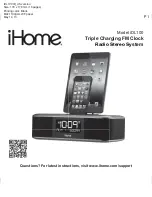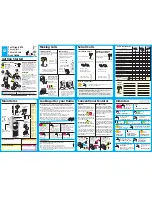
Model DBR2500
page 5
midlandusa.com
FCC NOTICE (Continued)
If this equipment does cause harmful interference to radio or television reception, which can
be determined by turning the equipment off and on, the user is encouraged to try to correct the
interference by one or more of the following measures:
•
Reorient or relocate the receiving antenna
•
Increase the separation between the equipment and receiver
• Connect the equipment into an outlet on a circuit different from that to which the receiver
is connected
•
Consult the dealer or an experienced radio/TV technician for help
IMPORTANT NOTICE, FCC LICENSE REQUIRED
The DBR2500 operates within Amateur (HAM) frequencies which require an FCC (Federal
Communications Commission) license� You must be licensed prior transmitting on this radio�
Serious penalties could result from unlicensed use of HAM channels, in violation of FCC rules,
as stipulated in the Communications Act’s Sections 501 and 502 (amended)�
You will be issued a call sign by the FCC which should be used for station identification when
operating the radio on Amatuer (HAM) channels� You should also cooperate by engaging in
permissible transmissions only, avoiding channel interference with other HAM users, and being
prudent with the length of your transmission time�
To obtain a license or ask questions about the application, contact the FCC at 1-888-CALL FCC
or go to the FCC’s website: http://www�fcc�gov and request form 605�
Exposure To Radio Frequency Energy
Your Midland radio is designed to comply with the following national and international standards
and guidelines regarding exposure of human beings to radio frequency electromagnetic energy�
•
United States Federal Communications Commission, Code of Federal Regulations: 47
CFR part 2 sub-part J
•
American National Standards Institute (ANSI)/Institute of Electrical & Electronics
Engineers (IEEE) C95� 1-1992
•
Institute of Electrical and Electronics Engineers (IEEE) C95� 1-1999 Edition
•
National Council on Radiation Protection and Measurements (NCRP) of the United
States, Report 86, 1986
•
International Commission on Non-lonizing Radiation Protection (ICNIRP) 1998
•
To control your exposure and ensure compliance with the general population or
uncontrolled environment exposure limits, transmit no more than 50% of the time� The
radio generates measurable RF energy exposure only when transmitting�
•
The consumer must maintain a minimum safe separation distance of 23�6 inches (60
cm) from the antenna when transmitting�
Содержание DBR2500
Страница 1: ......
Страница 33: ...Model DBR2500 page 33 midlandusa com SPECIFICATIONS ...
Страница 39: ...Model DBR2500 page 39 midlandusa com ...






































